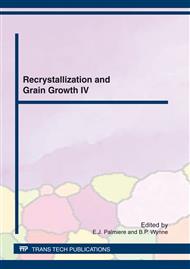p.89
p.96
p.102
p.103
p.109
p.115
p.122
p.128
p.134
Stored Energy of Goss Grains in Fe-3%Si Steel after Cold Rolling
Abstract:
According to a sub-boundary enhanced solid-state wetting mechanism, abnormally-growing Goss grains in Fe-3%Si steel are expected to have exclusively sub-boundaries which would be formed during primary recrystallization. This microstructural feature is related with the stored energy of Goss grains after cold rolling. To investigate the possibility of existence of sub-boundary exclusively in Goss grains after primary recrystallization, the deformation feature focused on stored energy of Goss and other specific orientations was analyzed by crystal plasticity finite element method calculations. The calculations indicated that Goss grains stored the lowest energy among the orientations formed after plane strain deformation.
Info:
Periodical:
Pages:
109-114
Citation:
Online since:
April 2012
Authors:
Price:
Сopyright:
© 2012 Trans Tech Publications Ltd. All Rights Reserved
Share:
Citation:


